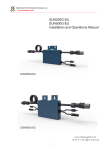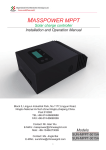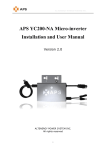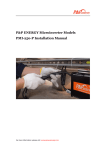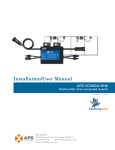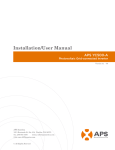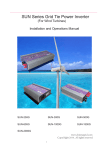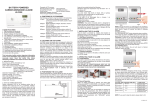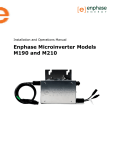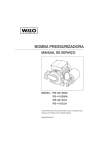Download User Manual for SUN250G-US SUN500G-US
Transcript
SUN250G SUN500G Installation and Operations Manual SUN250G SUN500G www.chinesegrid.com 2013-8-1 All rights reserved 1 Contact Information ADDRESS: Block 5, Lingyun Industrial Park, No.1177,Lingyun Road, Ningbo National Hi-Tech Zone Ningbo,zhejiang,China. Post:315000 TEL:+86-574-86699988 FAX:+86-574-86698369 Contact: Mr. Alan Wu E-MAIL: [email protected] Mob: +86-13738871588 Contact: Ms. Jingle Bai E-MAIL: [email protected] 2 Table of Contents Important Safety Information ------------------------------------------------------------------------------Read this First ---------------------------------------------------------------------------------------Safety Instructions ---------------------------------------------------------------------------------The Sunshine Microinverter System -------------------------------------------------------------------How the Microinverter Works --------------------------------------------------------------------System Monitoring -------------------------------------------------------------------------Optimal Reliability -------------------------------------------------------------------------Microinverter Models SUN250G and SUN500G --------------------------------------------Sunshine Microinverter Installation ----------------------------------------------------------------------Parts Included ---------------------------------------------------------------------------------------Other Parts and Tools Required ------------------------------------------------------------------Lightning Surge Suppression ---------------------------------------------------------------------Installation Procedure ------------------------------------------------------------------------------Step 1 - Install the AC Branch Circuit Junction Box -----------------------------------------Step 2 - Attach the Microinverters to the Racking -------------------------------------------Step 3 - Connect the Microinverter Wiring Harnesses -------------------------------------Step 4 – Ground the System ----------------------------------------------------------------------Step 5 – Complete the Map and Connect the PV Modules -------------------------------Complete the Sunshine Map -------------------------------------------------------------Alternative: Create Your Own Map ----------------------------------------------------Connect the PV Modules -----------------------------------------------------------------Step 6 – Build the Virtual Array -------------------------------------------------------------------Commissioning ------------------------------------------------------------------------------------------------Operating Instructions ---------------------------------------------------------------------------------------Troubleshooting -----------------------------------------------------------------------------------------------Status LED Indications and Error Reporting --------------------------------------------------Startup LED Operation: -------------------------------------------------------------------Post-Startup LED Indications ------------------------------------------------------------Other Faults ----------------------------------------------------------------------------------Troubleshooting an Inoperable Microinverter -------------------------------------------------Disconnecting a Microinverter from the PV Module -----------------------------------------Installing a Replacement Microinverter ---------------------------------------------------------Technical Data -------------------------------------------------------------------------------------------------SUN250G-US ------------------------------------------------------------------------------------------SUN250G-US ------------------------------------------------------------------------------------------- 4 4 4 5 6 6 6 7 8 8 8 8 9 10 10 11 12 13 13 13 14 14 14 14 15 15 15 15 15 17 17 17 19 20 21 Appendix ---------------------------------------------------------------------------------------------------------Sunshine Installation Map --------------------------------------------------------------------------Sample Wiring Diagram, SUN250G-208-US --------------------------------------------------Sample Wiring Diagram, SUN250G-240-US --------------------------------------------------Sample Wiring Diagram, SUN500G-208-US --------------------------------------------------Sample Wiring Diagram, SUN500G-240-US --------------------------------------------------- 22 22 23 24 25 26 3 Important Safety Information Read this First This manual contains important instructions to follow during installation and maintenance of the Sunshine Microinverter. To reduce the risk of electrical shock, and to ensure the safe installation and operation of the Sunshine Microinverter, the following safety symbols appear throughout this document to indicate dangerous conditions and important safety instructions. WARNING! This indicates a situation where failure to follow instructions may be a safety hazard or cause equipment malfunction. Use extreme caution and follow instructions carefully. NOTE: This indicates information particularly important for optimal system operation. Follow instructions closely. Safety Instructions WARNING: Be aware that the body of the Sunshine Microinverters is the heat sink and can reach a temperature of 80℃ under extreme conditions. To reduce risk of burns, do not touch. - Perform all electrical installations in accordance with all local electrical codes and the National Electrical Code (NEC), ANSI/NFPA 70. - Be aware that only qualified personnel should install and/or replace Sunshine Microinverters. - Do not attempt to repair the Sunshine Microinverter; it contains no user-serviceable parts. If it fails, please contact Sunshine customer service to obtain an RMA number and start the replacement process. Tampering with or opening the Sunshine Microinverter will void the warranty. - Before installing or using the Sunshine Microinverter, please read all instructions and cautionary markings in the technical description and on the Sunshine Microinverter system and the PV-array. - Connect the Sunshine Microinverter to the electrical utility grid only after receiving prior approval from the utility company. - Do NOT disconnect the PV module from the Sunshine Microinverter before removing AC power. 4 The Sunshine Technology Microinverter System The Sunshine Microinverter System is the world’s most technologically advanced inverter system for use in utility-interactive applications. This manual details the safe installation and operation of the Sunshine Microinverter. The three key elements of a Sunshine Microinverter System are: - the Sunshine Microinverter - the Sunshine Microinverter Energy collecting device (ECD) - the Sunshine Microinverter Energy monitoring and analyzer (EMA) This integrated system maximizes energy harvest, increases system reliability, and simplifies design, installation and management. 1 4 3 1 Sunshine Microinverter System - installed on the racking beneath each solar module - maximizes energy harvest 2 AC power travels over AC wring to the load center - performance data is also via the AC wring - plug and play communications 3 ECD communication - plug into same AC outlet - collects information via the AC wring - transmits data through a standard ethernet router to the internet 4 Standard Ethernet Router - information collected by the ECD is then transmitted to EMA. 5 EMA Monitoring - provides moniforing and analysis - performnace information can be viewed from any web browser 2 5 5 How the Microinverter Works The Sunshine Microinverter maximizes energy production from your photovoltaic (PV) array. Each Sunshine Microinverter is individually connected to one PV module in your array. This unique configuration means that an individual Maximum Peak Power Point Tracker (MPPT) controls each PV module. This insures that the maximum power available from each PV module is exported to the utility grid regardless of the performance of the other PV modules in the array. That is, although individual PV modules in the array may be affected by shading, soiling, orientation, or module mismatch, the Sunshine Microinverter insures top performance for its associated PV module. The result is maximum energy production from your PV system. System Monitoring Indoors, you can install the Microinverter Energy collecting device by plugging it into the same wire wall socket and providing an Ethernet connection to your broadband router or modem. After installation of the ECD, the full network of Sunshine Microinverters automatically begins reporting to the Sunshine Microinverter Energy monitoring and analyzer web server. The ECD software presents current and historical system performance trends, and it informs you when the PV system is not performing as expected. Optimal Reliability Sunshine Microinverter systems are also inherently more reliable than centralized or string inverters. The distributed nature of a microinverter system ensures that there is no single point of system failure in the PV system. Sunshine Microinverters are designed to operate at full power at ambient temperatures as high as 65C (150F). The inverter housing is designed for outdoor installation and complies with the NEMA6 environmental enclosure rating standard: NEMA6 rating definition: Indoor or outdoor use primarily to provide a degree of protection against hose-directed water, and the entry of water during occasional temporary submersion at a limited depth, and damage from external ice formation. Ease of Design PV systems using Sunshine Microinverters are very simple to design and install. You will not need string calculations, and you can install individual PV modules in any combination of module quantity, type, age and orientation. You won’t need to install cumbersome centralized or string inverters. Each microinverter quickly mounts on the PV racking, directly beneath each PV module. Low voltage DC wires connect from the PV module directly to the co-located microinverter, eliminating the risk of personnel exposure to lethal 600Vdc power. 6 Sunshine Microinverter Models SUN250G and SUN500G The Sunshine SUN250G microinverters are electrically compatible with most 60 and 84 cell PV modules. The SUN500G microinverters are electrically compatible with most Two Piece 60 and 84 cell PV modules. For more information, see the Technical Data section on page 19 of this manual. Refer to the Sunshine website (http://www.chinesegrid.com) for a list of electrically compatible PV modules and approved PV module racking systems. To ensure mechanical compatibility, be sure to order the correct connector type for both microinverter and PV module from your distributor. See the Sunshine website (http://www.chinesegrid.com) for a list of approved PV module racking systems. The following table summarizes electrical compatibility. Model Number Works with PV Module Type Maximum Microinverters per AC branch circuit SUN250G-208-US-R 60 to 90 cell 14 SUN250G-208-US 60 to 90 cell 14 SUN250G-240-US-R 60 to 90 cell 14 SUN250G-240-US 60 to 90 cell 14 SUN500G-208-US-R SUN500G-208-US SUN500G-240-US-R SUN500G-240-US Two piece of 60 to 90 cell Two piece of 60 to 90 cell Two piece of 60 to 90 cell Two piece of 60 to 90 cell 9 9 9 9 7 Module Connector Type DC:MC4 AC:Directly connected DC:MC4 AC:Wieland RST 25i3 DC:MC4 AC:Directly connected DC:MC4 AC:Wieland RST 25i3 DC:MC4 AC:Directly connected DC:MC4 AC:Wieland RST 25i3 DC:MC4 AC:Directly connected DC:MC4 AC:Wieland RST 25i3 Works with Service Type 208 VAC Three Phase 208 VAC Three Phase 240 VAC Single Phase 240 VAC Single Phase 208 VAC Three Phase 208 VAC Three Phase 240 VAC Single Phase 240 VAC Single Phase Sunshine Microinverter Installation Follow the instructions in this section to install Sunshine SUN250G and SUN500G Microinverters. WARNING: Before installing the Sunshine Microinverter, read all instructions and cautionary markings in the user manual, on the Sunshine Microinverter, and on the photovoltaic array. WARNING: Perform all electrical installations in accordance with all local electrical codes and the National Electrical Code (NEC), ANSI/NFPA 70. in US or the Canadian Electrical Code (CEC) in Canada. WARNING: Connect the Sunshine Microinverter to the electrical utility grid only after receiving prior approval from the utility company. WARNING: Be aware that only qualified personnel should connect the Sunshine Microinverter to the electrical utility grid. WARNING: Be aware that installation of this equipment includes risk of electric shock. Normally grounded conductors may be ungrounded and energized when a ground fault is indicated. WARNING:This unit is provided with fixed trip limits and shallnot be aggregated above 30 kW on a single Point of Common Connection Parts Included In addition to the microinverters, PV modules, racking, and associated hardware, you’ll need the microinverter installation kit. This kit includes the following items - Protective end cap - Mounting Bracket (adapter plate) - AC interconnect cable, 6 foot length Other Parts and Tools Required In addition to your PV array and its associated hardware, you will need to provide the following: - Junction box - Continuous grounding conductor, grounding washers - Number 2 Phillips screwdriver - Sockets, wrenches for mounting hardware - Torque wrench - Mounting hardware suitable for module racking Lightning Surge Suppression In some areas, the statistical frequency of lightning strikes near a PV installation is high enough that lightning protection should be installed as part of an Sunshine system. In areas with lighting flashes greater than 8.0 per square mile per year, the following protection device is recommended. It has been tested to ensure that it does not interfere with power line communications. 8 Installation Procedure Installing the Sunshine Microinverter System involves several key steps: 1. Measuring service and Installing the AC branch circuit junction box 2. Attaching the Sunshine Microinverters to the racking 3. Connecting the Sunshine Microinverter wiring harnesses 4. Grounding the system 5. Completing the Sunshine installation map and Connecting the PV modules Each of the detailed installation steps in the following sections is numerically referenced in the installation diagram below. WARNING: DO NOT connect Sunshine Microinverters to the utility grid or energize the AC circuit(s) until you have completed all of the installation procedures as described in the following sections. 9 Step 1 - Install the AC Branch Circuit Junction Box 1. Measure service entrance conductors to confirm AC service at the site. Acceptable ranges are shown in the table below: 2. Mount the Sunshine Adapter Plate at a suitable location on the PV racking system (typically at the end of a row of modules). 3. Install an appropriate junction box with adapter plate. WARNING: Only use electrical system components approved for wet locations. 4. Connect the open wire end of the Sunshine AC interconnect cable into the junction box using an appropriate gland or strain relief fitting. The AC interconnect cable requires a strain relief connector with an opening of 3/8 inches in diameter. Step 2 - Attach the Microinverters to the Racking system. a. Mark the approximate centers of each PV module on the racking Evaluate the location of the microinverter with respect to the PV module junction box or any other obstructions. WARNING: Allow a minimum of 0.75 inches between the top of the roof and the bottom of the microinverter. We also recommend that you allow 0.50 inches between the back of the PV module and the top of the inverter. Do not mount the microinverter in a location that allows long-term exposure to direct sunlight. b. If using grounding washers (e.g., WEEB) to ground the microinverter chassis to the PV module racking, choose a grounding washer that is approved for the racking manufacturer. Install a minimum of one grounding washer per microinverter. Torque the microinverter fasteners to the values listed below. -1/4°± mounting hardware(R) 45 inlbs minimum -5/16°± mounting hardware(R) 80 inlbs minimum 10 Step 3 - Connect the Microinverter Wiring Harnesses Each microinverter comes with one 3-pin bulkhead receptacle (or short pigtail) and one 70-inch AC wire harness with multi-pin connectors. (The DC input wires are approximately six inches long and are terminated with single pole connectors.) The AC connectors are oppositely sexed, so that multiple inverters can be connected to form one continuous AC branch circuit. When you perform this step, refer to the wiring diagram for your microinverter model. These diagrams are located in the Appendix of this manual. a. Orient the first microinverter in each branch with its male connector facing the junction box. The junction box AC interconnect cable has a female connector. The microinverter can be mounted with either side facing up to accommodate cable routing. Connect the first microinverter to the AC interconnect cable. All AC interconnect cables have three conductors. Wire them as follows depending on your microinverter model: L1 L2 L1 L2 b.Plug the AC connector of the first microinverter into the connector of the next microinverter, and so forth, to form a continuous AC branch circuit. Please check the microinverter rating label for the maximum allowable number of microinverters on one AC branch circuit. 11 NOTE: The AC and DC connectors of each microinverter have been evaluated and approved for use as the load break disconnect as required by the NEC. WARNING: Do NOT exceed the maximum number of microinverters in an AC branch circuit, as displayed on the unit-rating label. Each microinverter AC branch circuit must be sourced from a dedicated branch circuit protected by a 25A maximum breaker. c. Install a protective end cap on the open AC connector of the last microinverter in the AC branch circuit. WARNING: Make sure protective end caps have been installed on all unused AC connectors. Unused AC microinverter wire harness connectors are live when the system is energized by the utility system. WARNING: Size the AC wire gauge to account for voltage drop. All components of system wiring must be considered, including internal voltage Step 4 – Ground the System If you are not using grounding washers to ground the microinverter chassis as described in step 2, follow the step below. Each Sunshine Microinverter comes with a ground clip that can accommodate a 6-10 AWG conductor. a. Route a continuous GEC through each of the microinverters to the NEC approved AC grounding electrode. The racking and module could be grounded to this conductor using a crimp connection. An alternative method would be to connect the microinverter to the grounded racking using a grounding washer approved for the racking. NOTE: The AC output neutral is not bonded to ground inside the microinverter. 12 Step 5 – Complete the Map and Connect the PV Modules The Sunshine Installation Map is a diagrammatic representation of the physical location of each microinverter in your PV installation. The virtual array in Enlighten is created from the map you create. Use the blank map in the Appendix to record microinverter placement for the system, or provide your own layout if a larger or more intricate installation map is required. a. Each Sunshine Microinverter has a removable serial number label located on the mounting plate. Peel the removable serial number label from each Sunshine Microinverter and affix it to the respective location on the Sunshine installation map (see map on page 24). Remember to keep a copy of the installation map for your records. Alternative: Create Your Own Map a. Draw a top-down view of the array using the Array Map template (using either the grid on Side A or the freeform area on Side B). Make sure to leave enough room to place the serial number stickers. b. When installing the microinverters, remove the serial number labels located next to the DC input cables and place them in the correct order on your drawing of the system. Remember to keep a copy of the installation map for your records. Connect the PV Modules NOTE: Completely install all microinverters and all system inter-wiring connections prior to installing the PV modules. a. Mount the PV modules above their corresponding microinverters. Each microinverter comes with two oppositely sexed DC connectors. b. First connect the positive DC wire from the PV module to the negatively marked DC connector (male pin) of the microinverter. Then connect the negative DC wire from the PV module to the positively marked DC connector (female socket) of the microinverter. Repeat for all remaining PV modules using one microinverter for each module. . 13 Step 6 – Build the Virtual Array In this step, you will create the virtual array in EMA from the map you created in the last step. Once the virtual array is built, EMA displays a graphic representation of the PV system. It also shows detailed current and historical performance information. Commissioning WARNING: Connect the Sunshine Microinverter to the electrical utility grid only after receiving prior approval from the utility company. WARNING: Be aware that only qualified personnel must connect the Sunshine Microinverter to the electrical utility grid. WARNING: Ensure that all AC and DC wiring is correct. Ensure that none of the AC and DC wires are pinched or damaged. Ensure that all junction boxes are properly closed. NOTE: The Status LED of each microinverter will blink Red one times like heartbeat to indicate normal start-up operation one minute after DC power is applied. To commission the Sunshine Microinverter PV system: 1. Turn ON the AC disconnect or circuit breaker on each microinverter AC branch circuit. 2. Turn ON the main utility-grid AC circuit breaker. Your system will start producing power after a one-minute wait time. 3. The Sunshine Microinverters will start to send performance data over the power lines to the ECD. The time required for all the microinverters in the system to report to the ECD will vary with the number of microinverters in the system. The first units should be detected within 5 minutes but the entire system could take hours to detect. Please refer to the ECD Installation and Operation Manual for information on the ECD Operating Instructions The Sunshine microinverter is powered on when sufficient DC voltage from the module is applied. The status LED will flash Red one times like heartbeat one minute after DC power is applied. These Red blinks indicate proper start–up. NOTE: This inverter must be used with an external GFDI device as required by the Article 690 of the National Electrical Code for the installation location. You can also verify proper operation of the Sunshine Microinverters via the ECD. See the ECD Communications Gateway Installation and Operation Manual for more information. 14 Troubleshooting Adhere to all the safety measures described throughout this manual. Qualified personnel can use the following troubleshooting steps if the PV system does not operate correctly. WARNING: Do not attempt to repair the Sunshine Microinverter; it contains no user-serviceable parts. If it fails, please contact Sunshine customer service to obtain an RMA number and start the replacement process. Status LED Indications and Error Reporting Each Sunshine microinverter has an LED that indicates status as follows: Startup LED Operation: One minute after DC power is first applied to the microinverter, One short Red blinks indicate a successful microinverter startup sequence. be equal or greater than Two short red blinks after DC power is first applied to the microinverter indicate a failure during microinverter startup. Post-Startup LED Indications: Flashing Blue LED slowly means produce the power.Blue LED flashes said the frequency of the power of the state, the faster the flashing means the greater power. Other Faults: All other faults can reported to the ECD or Red LED flash times. Refer to the ECD Installation and Operation Manual for a list of additional faults and troubleshooting procedures. a.Red LED falsh two times means Error of the PV input voltage Please check the microinverter input voltage is fit the PV output voltage b.Red LED falsh three times means Error of the Power grid voltage or frequency. Please check the inverter output voltage frequency is in line with the local grid WARNING: Be aware that only qualified personnel should troubleshoot the PV array or the Sunshine Microinverter. WARNING: Never disconnect the DC wire connectors under load. Ensure that no current is flowing in the DC wires prior to disconnecting. An opaque covering may be used to cover the module prior to disconnecting the module. WARNING: Always disconnect AC power before disconnecting the PV module wires from the Sunshine Microinverter. The AC connector of the first microinverter in a branch circuit is suitable as a disconnecting means once the AC branch circuit breaker in the load center has been opened. 15 WARNING: The Sunshine Microinverters are powered by DC power from the PV modules. Make sure you disconnect the DC connections and reconnect DC power to watch for the six short LED blinks one minute after DC is applied. 16 Troubleshooting an Inoperable Microinverter To troubleshoot an inoperable microinverter, follow the steps in the order shown: 1. Check the connection to the utility grid. Verify that the utility voltage and frequency are within allowable ranges shown in the Technical Data section on page 19 of this manual. 2. Verify utility power is present at the inverter in question by removing AC, then DC power. Never disconnect the DC wires while the microinverter is producing power. Re-connect the DC module connectors. After one minute, watch for one short LED blinks. 3. Check the AC branch circuit interconnection harness between all the microinverters. Verify that each inverter is energized by the utility grid as described in the previous step. 4. Make sure that any AC disconnects are functioning properly and are closed. 5. Verify the PV module DC voltage is within the allowable range shown in the Technical Data section on page 19 of this manual. 6. Check the DC connections between the microinverter and the PV module. 7. If the problem persists, please call customer support at Sunshine. WARNING: Do not attempt to repair the Sunshine Microinverter; it contains no user-serviceable parts. If troubleshooting methods fail, please return the microinverter to your distributor for maintenance. Disconnecting a Microinverter from the PV Module To ensure the microinverter is not disconnected from the PV modules under load, adhere to the following disconnection steps in the order shown: 1. Disconnect the AC by opening the branch circuit breaker. 2. Disconnect the first AC connector in the branch circuit. 3. Cover the module with an opaque cover. 4. Using a DC current probe, verify there is no current flowing in the DC wires between the PV module and the microinverter. 5. Care should be taken when measuring DC currents, most clamp-on meters must be zeroed first and tend to drift with time. 6. Disconnect the PV module DC wire connectors from the microinverter. 7. Remove the microinverter from the PV array racking. Installing a Replacement Microinverter 1. Attach the replacement microinverter to the PV module racking using hardware recommended by your module racking vendor. If you are using grounding washers (e.g., WEEB) to ground the chassis of the microinverter, the old grounding washer should be discarded, and a new grounding washer must be used when installing the replacement microinverter. Torque the microinverter fasteners to the values listed below: x 1/4” mounting hardware – 45 in-lbs minimum x 5/16” mounting hardware – 80 in-lbs minimum 17 2. If you are using a grounding electrode conductor to ground the microinverter chassis, attach the grounding electrode conductor to the microinverter ground clamp. 3. Connect the AC cable of the replacement microinverter and the neighboring microinverters to complete the branch circuit connections. 4. Energize the branch circuit breaker, and verify operation of the replacement microinverter by checking the indicator light. 18 Technical Data Be sure to verify the voltage and current specifications of your PV module match with those of the microinverter. WARNING: You must match the DC operating voltage range of the PV module with the allowable input voltage range of the Sunshine Microinverter. WARNING: The maximum open circuit voltage of the PV module must not exceed the specified maximum input voltage of the Sunshine Microinverter. The output voltage and current of the PV module depends on the quantity, size and temperature of the PV cells, as well as the solar insolation on each cell. The highest PV module output voltage occurs when the temperature of the cells is the lowest and the module is at open circuit (not operating). The maximum short circuit current rating of the module must be equal to or less than the maximum input DC short circuit current rating of the microinverter. 19 MICROINVERTER TECHNICAL DATA SUN250G-US 60 to 90 Cell Modules INPUT DATA (DC) SUN-250G-US Recommended input power (STC) 210 - 300 W Maximum input DC voltage 60 V Peak power tracking voltage 25 V - 55 V Operating range 20 V - 55 V Min/Max start voltage 25 V / 60 V Max DC short circuit current 13 A Max input current 10.4 A OUTPUT DATA (AC) @208 VAC @240 VAC Peak output power 250 W 250 W Maximum output power 225 W Nominal output current 1000mA 973mA Nominal voltage/range 208V/183V-228V 240V/211V-264V Nominal frequency/range 60.0/59.3-60.5 Hz 60.0/59.3-60.5 Hz Extended frequency range 60.0/59.3-60.5 Hz 60.0/59.3-60.5 Hz Power factor >0.95 Maximum units per branch 14 14 EFFICIENCY CEC weighted efficiency, 240 VAC 94.5 % CEC weighted efficiency, 208 VAC 94.0 % Peak inverter efficiency 95.0 % Static MPPT efficiency 99.0 % Night time power consumption 50 mW MECHANICAL DATA Ambient temperature range -40℃ to +65℃ Dimensions (WxHxD) 215 mm x 137 mm x 30 mm(without mounting bracket) Weight 2.0 kg Cooling Natural convection - No fans Enclosure environmental rating Outdoor - NEMA 6 FEATURES Compatibility Compatible with 60-82 cell PV modules. Communication Power line Compliance UL1741/IEEE1547 CAN/CSA-C22.2 NO. 107.1 Warranty 25years 20 MICROINVERTER TECHNICAL DATA SUN500G-US 60 to 90 Cell Modules INPUT DATA (DC) SUN-500G-US Recommended input power (STC) 210 - 300 W(two piece) Maximum input DC voltage 60 V Peak power tracking voltage 25 V - 55 V Operating range 20 V - 55 V Min/Max start voltage 25 V / 60 V Max DC short circuit current 13 A Max input current 10.4 A OUTPUT DATA (AC) @208 VAC @240 VAC Peak output power 500 W 500 W Maximum output power 450 W 450 W Nominal output current 2163mA 1875mA Nominal voltage/range 208V/184V-228V 240V/211V-264V Nominal frequency/range 60.0/59.3-60.5 Hz 60.0/59.3-60.5 Hz Extended frequency range 60.0/59.3-60.5 Hz 60.0/59.3-60.5 Hz Power factor >0.95 >0.95 Maximum units per branch 14 14 EFFICIENCY CEC weighted efficiency, 240 VAC 94.5% CEC weighted efficiency, 208 VAC 94.0% Peak inverter efficiency 95.0% Static MPPT efficiency (weighted, reference EN50530) 99.0 % Night time power consumption 50 mW MECHANICAL DATA Ambient temperature range -40℃ to +65℃ Dimensions (WxHxD) 230 mm x 165 mm x 30 mm (without mounting bracket) Weight 2.5 kg Cooling Natural convection - No fans Enclosure environmental rating Outdoor - NEMA 6 FEATURES Compatibility Compatible with 60-82 cell PV modules. Communication Power line Compliance UL1741/IEEE1547 CAN/CSA-C22.2 NO. 107.1 Warranty 25years 21 22 No. No. F No. No. E No. No. D No. No. C No. No. B No. No. A 12 1 12 1 12 1 12 1 12 1 12 1 Panel Group: Azimuth: Tilt: sheet___of____ 13 2 13 2 13 2 13 2 13 2 13 2 14 3 14 3 14 3 14 3 14 3 14 3 15 4 15 4 15 4 15 4 15 4 15 4 16 5 16 5 16 5 16 5 16 5 16 5 18 7 18 7 18 7 18 7 18 7 18 7 To Sheet______↓ 17 6 17 6 17 6 17 6 17 6 17 6 To Sheet______↑ 8 8 8 8 8 8 Sunshine Installation Map 9 9 9 9 9 9 10 10 10 10 10 10 11 11 11 11 11 11 Appendix 23 meter JUNCTION BOX GROUND BLACK L2 RED L1 YELLOW NEUTRAL Sunshine Sunshine Sunshine ECD Sunshine Sunshine Sunshine MAX 14 SUN250G MAX 14 SUN250G ETHERNET CABLE TO BROADBAND ROUTER Sunshine Sunshine Sunshine MAX 14 SUN250G Sample Wiring Diagram SUN250G-240-US Sunshine Sunshine Sunshine 24 meter JUNCTION BOX GROUND BLACK L2 RED L1 YELLOW NEUTRAL Sunshine Sunshine Sunshine ECD Sunshine Sunshine Sunshine MAX 14 SUN250G MAX 14 SUN250G ETHERNET CABLE TO BROADBAND ROUTER Sunshine Sunshine Sunshine MAX 14 SUN250G Sample Wiring Diagram SUN250G-208-US Sunshine Sunshine Sunshine 25 meter JUNCTION BOX GROUND BLACK L2 RED L1 YELLOW NEUTRAL ECD Sunshine Sunshine Sunshine ETHERNET CABLE TO BROADBAND ROUTER Sunshine Sunshine Sunshine Sample Wiring Diagram SUN500G-208-US Sunshine MAX 9 SUN500G Sunshine MAX 9 SUN500G Sunshine MAX 9 SUN500G 26 meter JUNCTION BOX GROUND BLACK L2 RED L1 YELLOW NEUTRAL ECD Sunshine Sunshine Sunshine ETHERNET CABLE TO BROADBAND ROUTER Sunshine Sunshine Sunshine Sample Wiring Diagram SUN500G-240-US Sunshine MAX 9 SUN500G Sunshine MAX 9 SUN500G Sunshine MAX 9 SUN500G


























